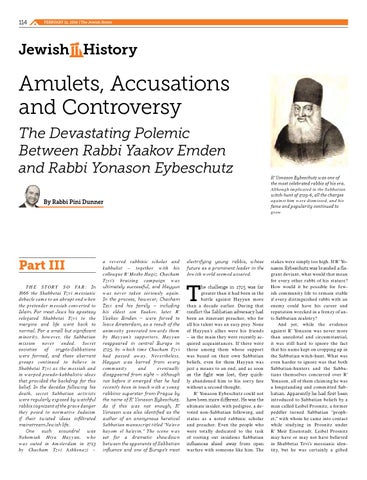114
FEBRUARY 11, 2016 | The Jewish Home
Jewish History
Amulets, Accusations and Controversy The Devastating Polemic Between Rabbi Yaakov Emden and Rabbi Yonason Eybeschutz By Rabbi Pini Dunner
Part III THE STORY SO FAR: In 1666 the Shabbetai Tzvi messianic debacle came to an abrupt end when the pretender messiah converted to Islam. For most Jews his apostasy relegated Shabbetai Tzvi to the margins and life went back to normal. For a small but significant minority, however, the Sabbatian mission never ended. Secret societies of crypto-Sabbatians were formed, and these aberrant groups continued to believe in Shabbetai Tzvi as the messiah and in warped pseudo-kabbalistic ideas that provided the backdrop for this belief. In the decades following his death, secret Sabbatian activists were regularly exposed by watchful rabbis cognizant of the grave danger they posed to normative Judaism if their twisted ideas infiltrated mainstream Jewish life. One such scoundrel was Nehemiah Hiya Hayyun, who was outed in Amsterdam in 1713 by Chacham Tzvi Ashkenazi –
a revered rabbinic scholar and kabbalist – together with his colleague R’ Moshe Hagiz. Chacham Tzvi’s bruising campaign was ultimately successful, and Hayyun was never taken seriously again. In the process, however, Chacham Tzvi and his family – including his eldest son Yaakov, later R’ Yaakov Emden – were forced to leave Amsterdam, as a result of the animosity generated towards them by Hayyun’s supporters. Hayyun reappeared in central Europe in 1725, by which time Chacham Tzvi had passed away. Nevertheless, Hayyun was barred from every community and eventually disappeared from sight – although not before it emerged that he had recently been in touch with a young rabbinic superstar from Prague by the name of R’ Yonason Eybeschutz. As if this was not enough, R’ Yonason was also identified as the author of an anonymous heretical Sabbatian manuscript titled “Va’avo hayom el ha’ayin.” The scene was set for a dramatic showdown between the opponents of Sabbatian influence and one of Europe’s most
electrifying young rabbis, whose future as a prominent leader in the Jewish world seemed assured.
T
he challenge in 1725 was far greater than it had been in the battle against Hayyun more than a decade earlier. During that conflict the Sabbatian adversary had been an itinerant preacher, who for all his talent was an easy prey. None of Hayyun’s allies were his friends – in the main they were recently acquired acquaintances. If there were those among them whose support was based on their own Sabbatian beliefs, even for them Hayyun was just a means to an end, and as soon as the fight was lost, they quickly abandoned him to his sorry fate without a second thought. R’ Yonason Eybeschutz could not have been more different. He was the ultimate insider, with pedigree, a devoted non-Sabbatian following, and status as a noted rabbinic scholar and preacher. Even the people who were totally dedicated to the task of rooting out insidious Sabbatian influences shied away from open warfare with someone like him. The
R’ Yonason Eybeschutz was one of the most celebrated rabbis of his era. Although implicated in the Sabbatian witch-hunt of 1725-6, all the charges against him were dismissed, and his fame and popularity continued to grow
stakes were simply too high. If R’ Yonason Eybeschutz was branded a flagrant deviant, what would that mean for every other rabbi of his stature? How would it be possible for Jewish community life to remain stable if every distinguished rabbi with an enemy could have his career and reputation wrecked in a frenzy of anti-Sabbatian zealotry? And yet, while the evidence against R’ Yonason was never more than anecdotal and circumstantial, it was still hard to ignore the fact that his name kept on cropping up in the Sabbatian witch-hunt. What was even harder to ignore was that both Sabbatian-hunters and the Sabbatians themselves concurred over R’ Yonason, all of them claiming he was a longstanding and committed Sabbatian. Apparently he had first been introduced to Sabbatian beliefs by a man called Leibel Prosnitz, a former peddler turned Sabbatian “prophet,” with whom he came into contact while studying in Prosnitz under R’ Meir Eisenstadt. Leibel Prosnitz may have or may not have believed in Shabbetai Tzvi’s messianic identity, but he was certainly a gifted
